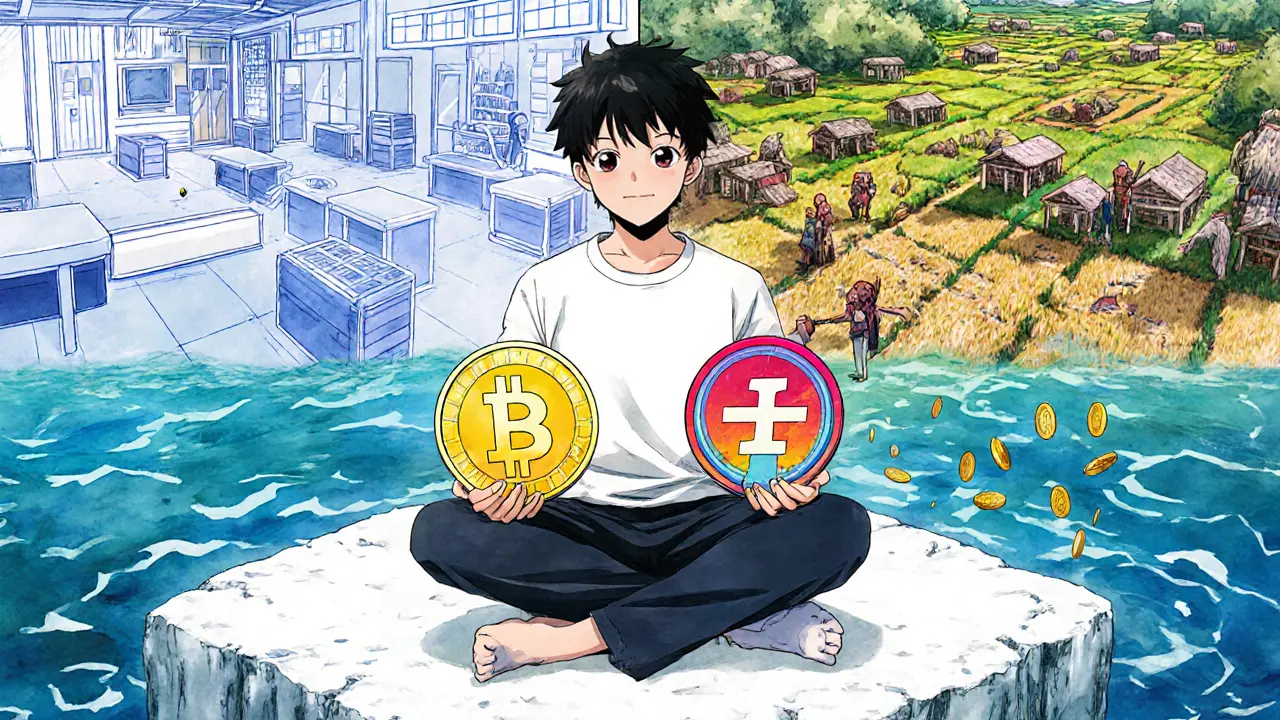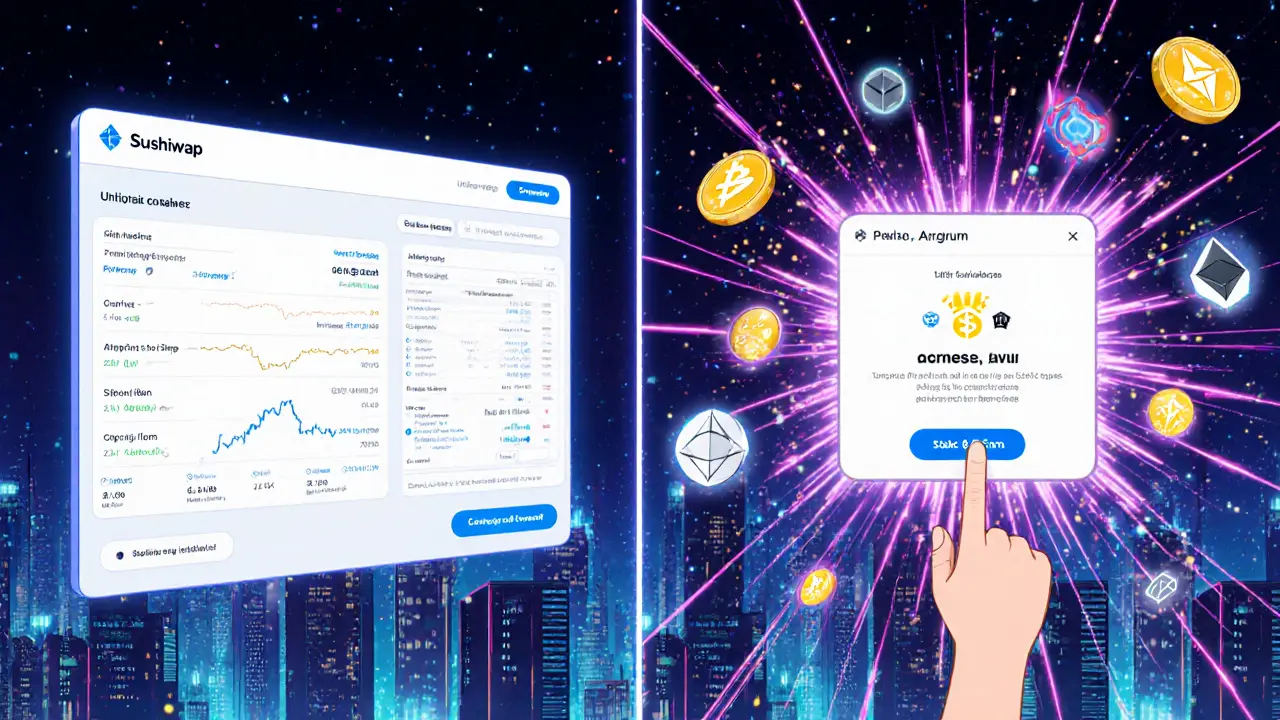DEX Fee Calculator
Compare DEX Trading Fees
See how much you'd pay to swap tokens on Uniswap versus SushiSwap. Based on article analysis of fee structures.
Which is better?
When you want to swap crypto without a middleman, you’re probably choosing between Uniswap and SushiSwap. Both let you trade tokens directly from your wallet, no sign-ups, no KYC. But they’re not the same. One is the quiet giant with deep pockets. The other is the reward-hungry hustler with a side of complexity. Which one fits your style? Let’s break it down.
What Makes Uniswap the Default Choice
Uniswap launched in 2018 and didn’t just enter the market-it rewrote the rules. It was the first to make automated market making (AMM) simple enough for anyone to use. Today, it handles $1-2 billion in daily trades and holds about $4 billion in locked liquidity. That’s more than ten times what SushiSwap manages. Why? Because it works. Every time you swap ETH for a new token, there’s a good chance you’re on Uniswap.
It’s not flashy. There are no extra tabs, no confusing menus. You connect your wallet, pick your tokens, set your slippage, and hit swap. Done. That’s why beginners stick with it. Even if you’ve never used a DEX before, Uniswap’s interface feels intuitive. Its mobile app is clean, reliable, and updates quietly in the background. No drama. No surprises.
Uniswap V3 introduced concentrated liquidity, which lets liquidity providers choose exact price ranges for their funds. That means you can earn more fees if you know your market. But it also means you need to pay attention. For most people just swapping tokens, the default 0.3% fee pool is all they need. Stablecoin pairs like USDC/ETH use a tighter 0.05% fee tier, which keeps slippage low and trades smooth.
UNI, the governance token, doesn’t pay staking rewards. You can’t earn passive income just by holding it. You can vote on proposals-like changing fees or adding new chains-but that’s it. If you’re not into governance, UNI is just a badge of participation. No income. No drama. Just a platform that keeps running.
SushiSwap: The Reward Machine
SushiSwap started as a fork of Uniswap. Literally. Someone copied the code, added token rewards, and called it a new project. That was 2020. Today, it’s still alive-not because it’s bigger, but because it’s smarter about incentives.
Every time you trade on SushiSwap, 0.3% of the fee goes to liquidity providers. But here’s the twist: 0.05% of that fee gets redirected to people who stake SUSHI tokens. That’s right. If you hold and stake SUSHI, you earn a cut of every trade. That’s direct, ongoing income. No need to farm, no need to lock up your tokens for months. Just stake and earn.
And if you want to go deeper? SushiSwap’s Onsen program gives bonus SUSHI rewards to liquidity providers on new or low-liquidity tokens. Want to back a new DeFi project? Provide liquidity, get extra SUSHI. It’s a powerful magnet for early adopters and yield farmers. That’s why SushiSwap has a loyal following among users who treat DeFi like a side hustle.
It also supports 14+ blockchains. You can trade on Ethereum, Polygon, Arbitrum, Avalanche, Fantom, and more-all from one interface. That’s huge. If you’re moving between chains to chase lower fees or faster speeds, SushiSwap gives you the tools. Uniswap only supports six major chains. For users who live across multiple networks, that’s a dealbreaker.
Who Should Use Which?
If you’re new to DeFi, start with Uniswap. You don’t need to understand staking, yield farming, or cross-chain bridges. Just swap tokens, move on. Uniswap’s simplicity reduces mistakes. Mistakes in DeFi cost money.
If you’ve been trading for a while and you’re looking to earn more than just trading fees, SushiSwap is your playground. You can stake SUSHI, farm rewards, use limit orders, and even lend assets-all in one place. But it’s not beginner-friendly. The interface is cluttered. The terms are dense. You’ll need to learn what xSUSHI is, how rewards compound, and how to bridge tokens safely.
Here’s a quick rule of thumb:
- Use Uniswap if you want speed, reliability, and zero stress.
- Use SushiSwap if you want to earn extra tokens and don’t mind learning a few extra steps.
Many experienced users run both. They use Uniswap for big, safe swaps-like ETH to USDC-and SushiSwap for speculative plays and yield farming. It’s not an either/or. It’s a strategy.

Token Economics: UNI vs SUSHI
UNI has a max supply of 1 billion tokens. It’s widely distributed, but most of it is locked up or held by institutions. Its value comes from governance power and brand recognition. But unless you’re voting on protocol changes, holding UNI doesn’t generate income.
SUSHI has a max supply of 250 million. That’s less than a quarter of UNI’s supply. And unlike UNI, SUSHI has a built-in income stream. Every time someone trades on SushiSwap, stakers get paid. That creates a feedback loop: more trading → more rewards → more people stake → more security → more trading.
That’s why SUSHI holders tend to be more engaged. They’re not just speculators-they’re stakeholders. Their financial interest is tied directly to the platform’s usage. UNI holders? Most just bought it during the 2020 airdrop and forgot about it.
Security and Trust
Both platforms have been audited. Both have never been hacked at the protocol level. That’s rare in DeFi. But trust isn’t just about code-it’s about time.
Uniswap has been running for over six years. It’s survived bear markets, regulatory scares, and countless imitators. Its code is battle-tested. Millions of daily users don’t just trust it-they rely on it. That kind of track record matters.
SushiSwap is younger. It’s had its rough patches. In 2020, its founder vanished with $14 million in ETH. The community took over, cleaned house, and rebuilt. That’s when SushiSwap proved it wasn’t just a team-it was a movement. Today, it’s governed by its users. But the memory lingers. For risk-averse traders, Uniswap still feels safer.

What’s Next?
Uniswap is expanding into NFTs. You can now buy and sell NFTs directly on its platform. It’s not trying to be everything-but it’s adding what makes sense: more ways to trade.
SushiSwap is doubling down on DeFi. It now offers lending, limit orders, and cross-chain yield aggregation. It’s becoming a one-stop shop for active traders. The goal isn’t to be the biggest-it’s to be the most useful for power users.
Competition is heating up. New DEXs like Curve, Balancer, and Trader Joe are carving out their own niches. But Uniswap and SushiSwap have something no new entrant can copy easily: liquidity. And liquidity is what makes DEXs work.
Final Verdict
Uniswap is the default. It’s the Google of decentralized exchanges. Simple, fast, reliable. If you just want to swap tokens without thinking too hard, this is your pick.
SushiSwap is the upgrade. It’s for people who want to earn while they trade. If you’re already deep in DeFi and looking for ways to boost your returns, SushiSwap gives you tools Uniswap doesn’t.
There’s no winner here. Just two different tools for two different users. Pick the one that matches your goals-not your hype.
Is Uniswap safer than SushiSwap?
Both platforms have never been hacked at the protocol level, and both have been audited. Uniswap has a longer track record-over six years of stable operation-which gives it more trust among risk-averse users. SushiSwap had a major controversy in 2020 but recovered through community governance. For most users, the safety difference is minimal, but Uniswap’s history gives it an edge in perceived reliability.
Can I earn rewards on Uniswap like I can on SushiSwap?
No. Uniswap doesn’t offer token rewards or staking incentives. All trading fees go directly to liquidity providers. If you want to earn extra tokens just for holding or staking, you need to use SushiSwap’s xSUSHI staking or its Onsen liquidity mining programs. Uniswap’s UNI token only lets you vote on proposals-it doesn’t generate income.
Which one has lower fees?
SushiSwap charges a flat 0.3% fee on all trades. Uniswap offers variable fees: 0.05% for stablecoin pairs, 0.3% for most tokens, and 1% for volatile ones. So if you’re swapping USDC for DAI, Uniswap is cheaper. For ETH to a new memecoin, both charge 0.3%. The fee difference only matters for specific token pairs.
Does SushiSwap work on mobile?
Yes, SushiSwap has a mobile app and works through wallet browsers like MetaMask on Android and iOS. But its interface is more complex than Uniswap’s. For beginners, the mobile experience can feel cluttered. Uniswap’s mobile app is cleaner and easier to navigate. If you’re on the go and just swapping tokens, Uniswap is the better mobile choice.
Should I use both Uniswap and SushiSwap?
Many experienced DeFi users do. Use Uniswap for simple, high-volume swaps-like trading ETH to stablecoins-because it’s fast and reliable. Use SushiSwap when you want to farm rewards, trade on alternative chains, or use advanced tools like limit orders. Running both gives you flexibility and lets you optimize for both speed and yield.
Which DEX is better for new crypto users?
Uniswap is far better for beginners. Its interface is clean, documentation is clear, and there’s no confusing reward system to learn. SushiSwap’s extra features-staking, farming, multi-chain support-can overwhelm someone just trying to swap ETH for a token. Start with Uniswap. Learn the basics. Then explore SushiSwap if you want to go deeper.


18 Responses
Uniswap is like that reliable best friend who shows up every time you need them-no drama, no fluff. I’ve used it for years, and honestly? I don’t even think about it anymore. Just swap, go. SushiSwap? That’s the cousin who’s always trying to get you into their latest side hustle. Fun, but exhausting. 🤷♀️
Bro, Uniswap’s liquidity is the backbone of DeFi. It’s not just a DEX-it’s infrastructure. Like the electrical grid for crypto. SushiSwap? That’s the startup trying to monetize every single interaction. The rewards are nice, sure, but at what cost? Complexity tax. And don’t even get me started on the cross-chain bridge roulette. 😅
Uniswap is for normies. SushiSwap is for people who actually want to build wealth. If you're just swapping ETH for DOGE because you saw a meme, go ahead and use Uniswap. But if you're serious about DeFi, you're missing out if you're not staking SUSHI and farming Onsen. Stop being lazy and start earning.
Uniswap is corporate crypto. Cold. Clinical. Safe. SushiSwap? That’s the wild west with a reward system. I love it. The fact that you get paid just for holding SUSHI? That’s not a feature-that’s a revolution. Why should you be rewarded for providing liquidity but not for holding the token that makes it all possible? Uniswap’s UNI is just a loyalty card. SUSHI is a stake in the future.
I just want to swap tokens. That’s it. Why does everything have to be a 10-level game now? SushiSwap feels like a crypto MLM. I’m not here to farm, stake, bridge, compound, delegate, and then pray for airdrops. I just want to buy Shiba and move on. Uniswap gets it. SushiSwap? It’s trying too hard. And honestly? It’s exhausting.
Look, both platforms are valid. It’s not about which one’s better-it’s about which one fits your vibe. Uniswap is the zen master. SushiSwap is the hype man at the rave. I use Uniswap for my stablecoin swaps-clean, fast, no noise. Then I hop over to SushiSwap to chase a new token with Onsen rewards. It’s like having a daily driver and a weekend toy. No need to pick a side. Just use both. 🤝
Uniswap’s interface is minimalist, yes-but that’s not simplicity. It’s neglect. SushiSwap, despite its clutter, offers functionality. And the reward mechanism? It’s not just clever-it’s mathematically elegant. The 0.05% fee redistribution to stakers creates a sustainable feedback loop. UNI holders? They’re passive. SUSHI holders? They’re aligned. There’s a difference.
I used to think Uniswap was the pinnacle. Then I tried SushiSwap. It’s like going from a Starbucks to a tiny, family-run café that gives you free cookies with your latte. The interface? A mess. The rewards? Life-changing. I don’t care if it’s ‘professional.’ I care that I’m earning while I trade. And honestly? I think most people who say Uniswap is better just haven’t tried the real game.
okay so i just started using crypto like 6 months ago and i was so confused by all the options… then i found uniswap and it was like… wow, this just works. no stress. no weird buttons. then my friend was like ‘you gotta try sushi’ and i did… and i got like 20 bucks in extra sushis just for holding?? i still dont know what xSUSHI is but i keep it. lol. uniswap for the basics, sushi for the free snacks. 🍣✨
There’s a philosophical distinction here that’s rarely discussed. Uniswap represents the ideal of decentralization as a neutral public good-accessible, immutable, apolitical. SushiSwap embodies decentralization as an active, participatory economy-where value creation is distributed, incentivized, and recursive. One is a tool. The other is a social contract. The choice isn’t technical-it’s ideological.
Uniswap is owned by VCs. SushiSwap was stolen and then reclaimed by the people. Who do you trust? The corporate-backed giant with a clean logo? Or the community that kicked out a thief and rebuilt it from scratch? That’s not just protocol-it’s character. And character matters. If you’re using Uniswap because it’s ‘safe,’ you’re not thinking. You’re just scared.
Uniswap is the default because it’s the easiest. But easy doesn’t mean best. SushiSwap’s reward system? That’s the future. And don’t tell me it’s ‘complicated’-if you can’t figure out how to stake a token in 2025, you shouldn’t be in crypto. Also, did you know SushiSwap is on 14 chains? Uniswap? 6. And you wonder why gas fees are still high? 🤦♂️
I’m from the UK, and I’ve been using both for over two years. Uniswap for big swaps-like ETH to USDC. SushiSwap for anything new or risky. The Onsen rewards? I’ve earned more in SUSHI than I’ve lost in slippage. And the mobile app? Yeah, it’s messy-but I’ve learned to ignore the noise. Focus on the rewards. That’s the real game.
Both are good. Uniswap is stable. SushiSwap is rewarding. I use Uniswap when I want to be safe. SushiSwap when I want to grow. No need to fight. Just choose based on what you need that day. Simple. 😊
Uniswap is a front. The real power is held by the core devs and institutional wallets. SushiSwap’s community governance? It’s a facade too. Both are controlled. The only difference is SushiSwap makes you think you have a voice. The rewards are just a distraction. Don’t be fooled. They’re both tools of the same system.
Uniswap is the Swiss Army knife. SushiSwap is the multi-tool with 17 attachments you never use. I’ve been in DeFi since 2021. I use Uniswap for 90% of my trades. SushiSwap? Only when I’m chasing a new token with bonus rewards. Otherwise? Too much noise. Less is more. Especially when your portfolio’s on the line.
Uniswap is a trap. They don’t pay rewards because they want you to hold UNI and get addicted to the brand. Then they sell it to whales. SushiSwap? They know you’re not here to just swap-you’re here to build. And they pay you for it. That’s why SUSHI’s price holds better. Because it’s not just speculation-it’s labor. And labor deserves compensation. Wake up.
Maybe we’re thinking about this wrong. What if the real win isn’t choosing one over the other? What if the future is using both-Uniswap for stability, SushiSwap for growth? No need to pick sides. Just use the right tool for the job. Simple. Clean. Effective. 🤝